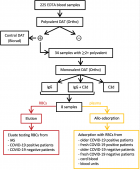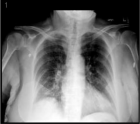Table of Contents
Survival and predictors of mortality among HIV-infected adults receiving ART in Hawassa comprehensive specialized hospital, Sidama regional state, Ethiopia
Published on: 25th November, 2022
Background: Having claimed lives, HIV/AIDS is still a significant global public health concern. Antiretroviral therapy (ART) is now widely available, and this rapid expansion of access is dramatically improving HIV epidemic survival rates worldwide.Objectives: The aim of this study was to identify the mortality risk factors and survival status of ART patients attending Hawassa Comprehensive Specialized Hospital in 2020.Methods: In a five-year retrospective cohort research, all patients seen between January 2015 and December 2019 were analyzed. The data were analyzed with SPSS 25.0. The Kaplan-Meier Log-rank model was employed to gauge the survival time of ART patients based on explanatory variables. Both bivariate and multivariate Cox proportional hazards regression models were employed to identify the independent causes of mortality.Results: Patients on ART had a 74% overall survival probability. With a median survival of 34 months, there are 0.135 deaths for every 100 person-years. Hemoglobin level (HR = 2.38; 95% CI = 3.3-6.3), WHO clinical stage III and IV (HR = 3; 95% CI = 2.2-9.5, p = 0.04), Age >=60 (HR = 1.6; 95% CI = 1.3-2, p = 0.04) and Functional status bed ridden (HR = 3.1; 95% CI = 1.2-9.4,p = 0.04) were all independent predictors of death among RVI patients.Conclusion: In comparison to trials conducted in wealthy countries, the survival rate of ART patients in this study was low. Patients who are anemic; WHO advanced clinical stage; old age, and functional status bedridden should be closely followed and monitored.
Atypic subacute sclerosing panensefalitis in a six-year-old male
Published on: 23rd November, 2022
Subacute sclerosing panencephalitis is a rare, slow, and insidious neurodegenerative disease caused by measles. This disease mostly has a classic course. However, sometimes it can be presented with atypical manifestations. In this paper, we aim to present a six years old male patient that was hospitalized due to seizures and ataxia. Cerebral magnetic resonance imaging was normal on the first day of admission, but within a few days, the patient started to be apathetic. On the seventh day, magnetic resonance imaging showed hyperintense lesions in the thalamic, brainstem, and periventricular areas. Periodic epileptiform discharges were detected in the repeated electroencephalogram. Investigations from the cerebrospinal fluid showed markedly elevated measles virus IgG at 230U/ml consistent with the diagnosis of SSPE which should always be ruled out when a patient comes in with uncontrollable seizures, ataxia and apathy.
Risk factors for esophageal strictures in children and adolescents with eosinophilic esophagitis
Published on: 27th October, 2022
Studies in children with eosinophilic esophagitis (EoE) have reported esophageal strictures but none have examined risk factors associated with strictures. Aim: To assess risk factors associated with strictures in children with EoE. Methods: In this retrospective study, children with EoE seen over 20 years were separated into two groups; with and without strictures. Physical features, CBC, endoscopic findings, and biopsy of the distal and mid-esophagus were captured. Statistical significance with p - value and multivariate logistic regression was done. Results: Total patients 222 and 20 (9.1%) had strictures. Mean age of stricture patients 12.7 years (range 7-18) and non-stricture 9.3 years (range 1-17) (p = 0.006). Among stricture patients following were prevalent and significant; dysphagia (stricture 100% vs. non-stricture 41.6%, p = 0.0005) and food impaction (70.04% vs. 4%, p = 0.0005); EGD: rings and exudates were strongly associated with stricture, 45.0% vs. 4.5%, p = 0.0005 and 60% vs. 30.7%, p = 0.008, respectively. Abdominal pain was lower in the stricture group (5% vs. 31.2%, p = 0.017). Eosinophil counts were numerically more in the stricture group but not significant. Multivariate logistic regression confirmed that strictures are likely to occur among patients with dysphagia (p = 0.02, OR = 11.7, 95% LCL 2.0) and food impaction (p = 0.0001, OR = 80.9, 95% LCL 15.4), respectively, adjusted for age and gender. Conclusion: EoE children with dysphagia or food impaction have a higher chance of having an esophageal stricture. These EoE children 12 years or over with exudates or rings on endoscopy, should be treated and carefully monitored, to reduce the risk of stricture formation.
Post-vaccine immunity against hepatitis B in Moroccan children
Published on: 2nd September, 2022
OCLC Number/Unique Identifier: 9617320088
Background: Hepatitis B is a major public health issue worldwide. Immunization of infants against this disease has been effective in Morocco since 1999. However, evaluation of post-vaccination response is rarely performed in our setting. The purpose of this study was to evaluate immunity against HBV in fully vaccinated children in the city of Marrakech in Morocco and to investigate the factors influencing the level of post-vaccination immunity. Methods: A descriptive cross-sectional study was conducted on fully vaccinated children who have medical and vaccination records, from three primary healthcare centers in Marrakech. Children with anti-HBs antibody levels between 10 and 100 IU/L were considered moderately immune, and those with antibody levels above 100 IU/L as highly immune, while those with antibody levels below 10 IU/L were considered non-immune. Results: Of the 123 children recruited, 114 (92.7%) had protective anti-HBs antibody titers, of which 37 (30%) were moderately immunized and 77 (62.7%) were highly immunized, and nine (7.3%) were non-immune. Age, birth weight, vaccine type, and time since the previous dose have all been significantly associated with the degree of post-vaccination immunity. Anti-HBs antibody levels were not significantly related to factors potentially linked to post-vaccination non-response, such as chronic disease, immunosuppressive medication and others.Conclusion: Our findings denote that the HBV vaccine used in The Moroccan Expanded Program on Immunization (EPI) is effective against HBV. Nevertheless, in non-responders, corrective actions such as re-vaccination and monitoring of post-vaccination anti-HBs antibody levels should be implemented.
What, how and when should we instruct mothers about neonatal jaundice
Published on: 30th July, 2022
OCLC Number/Unique Identifier: 9579209925
Most parents in affluent countries receive information about neonatal jaundice from instructional pamphlets and/or verbally from nurses before discharge. Predischarge protocols, content and delivery of information for parents, and screening for jaundice vary among hospitals. Newborns are usually screened either visually or with a transcutaneous monitor to estimate the intensity of jaundice. The timing of follow-up is guided by the newborn’s clinical status, age at discharge and risk of developing significant hyperbilirubinemia based on an hour-specific bilirubin level [1,2].
Can infants develop meningitis in the absence of bacteremia in the first ninety days of life? A retrospective chart review
Published on: 4th July, 2022
OCLC Number/Unique Identifier: 9554569888
The overall incidence of meningitis in infants 0-90 days is low; however, it remains a serious cause of morbidity and mortality among affected patients. It is standard of care to perform lumbar punctures as part of the work-up of fever in the first four weeks of life and sick-looking babies up to the age of 90 days. This particular procedure is often refused by parents, and physicians are left to predict the possibility of meningitis based on blood culture results.The aim of this study is to determine whether it would be safe to rule out meningitis based on a negative blood culture in this age group.
Effectiveness of different cord care interventions on omphalitis prevention among neonates in Nakuru County Hospital, Kenya
Published on: 5th May, 2022
Background: Sepsis among newborns is common and a major cause of neonatal deaths in developing countries. Annually, about 4 million neonatal deaths occur around the world. Of these, more than 30% are caused by infections majority of which start as umbilical cord infections. Topical umbilical cord care can reduce omphalitis (umbilical cord infection) and neonatal mortality among newborns.Objective: This study aimed to compare the incidence of omphalitis in different cord care interventions (Dry, Chlorhexidine, and Alcohol) in Nakuru County, Kenya. Methodology: A randomized controlled trial was carried out between July 2018 and June 2019. A total of 540 newborns were randomly assigned to receive 1 of 3 cord care regimens; twice cord cleansing with 4% chlorhexidine (Group 1), twice cord cleansing with 70% alcohol (Group 2), and dry cord care (Group 3) as control. Results: The risk of omphalitis was significantly reduced in the chlorhexidine group than in dry and alcohol cord care groups. The incidence of omphalitis was 1.95 times more likely to occur among the dry cord care group [AOR = 1.95; 95% CI = 1.13-3.38; p = 0.017] compared to the chlorhexidine group. Similarly, babies in the alcohol group were nearly 2 times more likely to develop omphalitis [AOR = 1.98; 95% CI = 1.15-33.40; p = 0.014] compared to those in the chlorhexidine group.Conclusion and recommendation: Chlorhexidine topical cord care significantly reduces the risk of umbilical infection in neonates when compared to both topical alcohol application and dry cord care approach. It should be recommended to be used topically for the prevention of omphalitis in our setup.
Pediatrics of disasters in the structure of professional training of pediatricians of the city children’s polyclinic to work in emergencies and terrorist acts: View from Russia
Published on: 16th February, 2022
OCLC Number/Unique Identifier: 9427642090
Introduction: Modern pediatrics of disasters is built on 5 basic principles: integrity, structure, causality, dynamism, and hierarchy.Material and methods: Methodological approaches were used: systemic, complex, integration, functional, dynamic, process, normative, quantitative, administrative, and situational, and methods: historical, analytical, and comparison. Techniques were used: grouping, absolute and relative values, detailing, and generalization.Results: The algorithms of actions of the doctor of the children’s clinic in the event of a fire, the receipt of a call about the laying of explosives and the threat of explosion were considered, the scope of the provision of first qualified aid to the pediatric nursing team was clarified. The issues of the organization of the first qualified and specialized medical care, taking into account the anatomical and physiological characteristics of children and adolescents, as well as medical tactics for small-medium, and large disasters in rural areas and cities are discussed.Conclusion: Pediatrics of disasters is an independent section of organizational and medical work in emergencies and terrorist acts, providing specialized medical care for at least 25% of victims, who are children and adolescents. The training of doctors of a specialized children’s polyclinic is regulated by regulatory documents of the Russian Federation and the Republic of Komi, Orders of the Ministry of Health of the region, a municipal formation, and a medical institution in the field of civil defense and emergency situations. In case of minor emergencies and disasters within the city boundaries with the occurrence of a single or a small number of group losses, medical support repeats that in road traffic accidents, with the exception of the organization and conduct of medical triage. In rural areas, it is required to attract additional medical and nursing teams (emergency medical aid teams), created on the basis of medical institutions of the victim and neighboring areas. At the same time, a forced maneuver by the forces and means of territorial health care is necessary for the medical evacuation of a significant part of the affected children to specialized institutions (departments) located in cities. The provision of psychological and psychiatric assistance to children and adolescents in emergencies is carried out on the basis of its basic modules (departments and offices of psychological and psychiatric assistance, and advisory mobile team of psychological and psychiatric assistance, anonymous psychological and psychiatric assistance by telephone).
Severe brimonidine eye drop intoxication in a neonate as an accidental oral ingestion
Published on: 4th January, 2022
OCLC Number/Unique Identifier: 9396214367
Brimonidine tartrate eye drops are a topical agent used to treat glaucoma in children over 2 years of age and adults. It is banned for children younger than 2 years of age because post-marketing studies have shown serious side effects. Colic is common in infants, which worries parents. And parents often use herbal and chemical medicines to solve this problem. We present a 12-day-old newborn with brimonidine eye drop intoxication, in which the drug was mistakenly administered orally to treat the colic problem.

If you are already a member of our network and need to keep track of any developments regarding a question you have already submitted, click "take me to my Query."
















































































































































